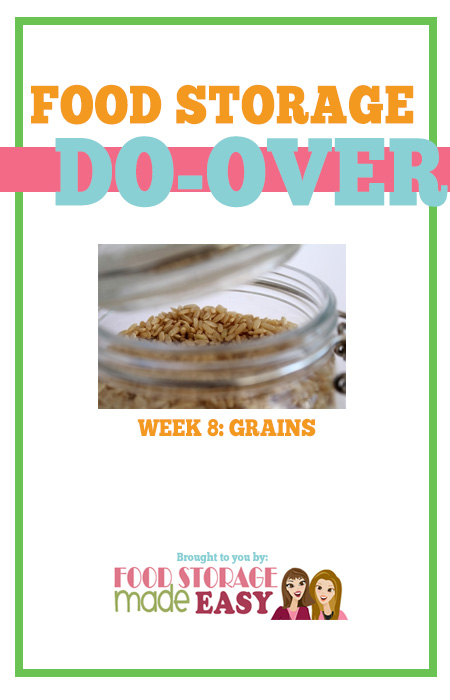We are excited to be starting week 8 of our Food Storage Do-Over 2015! If you didn’t catch last week’s post on revisiting your long term supply you can see it here. Also Julie did a post on how she revisited her long term supply plan here.
Remember this is a 17 week process that we will be going through together. If you want to join in with the group on Facebook click here. If you’d like to receive email notifications of each week’s do-over assignment you can join our mailing list here. Or you can always post in the blog comments with your progress as well! It is so much more fun and motivating doing it as a group so find a way to connect!

In BabyStep 5: Grains we discuss storing and using grains. We feel like it is very important to USE the foods you are storing so we focus on that a lot.

If you are brand new, we will walk you through the process of buying and starting to use your grains this week. Here are the tasks you will need to accomplish.
- Review the inventory list you worked on last week to get the total amount of grains you need for your complete food storage plan
- Start purchasing grains according to your budget (if you don’t have a grain mill/wheat grinder you may want to purchase flours instead of whole grains for now) – review our post on Best Ways to Purchase Traditional Food Storage for recommendations on where to buy
- Purchase or start saving up for a wheat grinder (see our recommendations in the product section below)
- Learn more about wheat, oats, rice, corn/cornmeal, and barley by reading our posts on those topics
- Read 7 Ways to Use Wheat Without a Wheat Grinder and try some of the ideas
- Look at our Recipes page and our Pinterest boards for ideas of recipes to try using grains
- If you have (or buy) a wheat grinder, read 17 Ways to Use a Wheat Grinder and try out some of the ideas using your newly purchased grains
Additional Things to Consider
- The standard recommendation for storing grains is to store 300 pounds of grain per adult per year. Half that amount for children 7 and under.
- Wheat is the most common grain to store, but you don’t have to store only wheat. The amounts on standard calculators can be swapped out pound for pound with other grains.
- If you have wheat allergies check out the additional resources at the bottom of this post for alternatives.
- Try making things like pancakes or pizza dough before jumping into making bread if you’re new at this
- Consider purchasing different kinds of grains and flours and try them before you store hundreds of pounds of something you may not like or tolerate very well
- Don’t switch to 100% whole grains overnight, do half and half at first to allow your digestive system time to adapt.
Don’t forget to come over and share your progress in our Food Storage Do-Over Facebook Group!

If you have some grains already stored and feel somewhat comfortable with them step outside your comfort zone and try something new:
- Review your inventory list from last week and replenish any items from the grains section that you don’t have your full supply of.
- Try using 2-3 grains you never have before this week. Good places to use new grains are in pancake mixes.
- Print recipes you use often if you only have them on the computer.
- Make sure you have 2-3 recipes that use each grain in your food storage and store all the necessary ingredients to make them.
- Try making sourdough with your wheat and a sourdough starter.
- Try making bread without electricity at all. How well would you do?
Don’t forget to come over and share your progress in our Food Storage Do-Over Facebook Group!

 |
WONDERMILL GRAIN MILL: An electric mill is an important tool for rotating and practicing using all of your grains, not just wheat. |
 |
WONDER JUNIOR DELUXE: A manual wheat grinder is useful for powerless emergencies and also to grind oily items like nuts and seeds. |
 |
BOSCH MIXERS: If you are planning to get into bread baking with your wheat, a Bosch mixer will be a great tool to add to your kitchen. |

Wheat / Wheat Grinders
Let’s Talk About Wheat – from Food Storage Made Easy
7 Ways to Use Wheat Without a Wheat Grinder – from Food Storage Made Easy
Wheat Grinder Overview (Pros and Cons) – from Food Storage Made Easy
Wheat Grinder Video – from Food Storage Made Easy
Breads / Cooking with Wheat
BREADS PINTEREST BOARD
Grinding Flour + 6 Fresh Flour Baking Tips – from Melissa K Norris
Top 5 Reasons to Grind Your Own Wheat – from The Bread Geek
BEST Wheat Bread Recipe – from Food Storage Made Easy
Top 12 Questions About Baking Bread – from Food Storage Made Easy
Bread – No grinding, no kneading, no electricity … no problem – from Food Storage Made Easy
Sourdough 101 – from Food Storage Made Easy
17 Ways to Use a Wheat Grinder – from Food Storage Made Easy
Other Grains / Wheat Alternatives
GRAINS PINTEREST BOARD
Grains Overview Page – from Food Storage Made Easy
How to Soak Grains and Why We Should – from Whole New Mom
Alternatives to Wheat – from The Survival Mom
Sources for Alternative Grains – from Food Storage Made Easy
Let’s Talk About Oats – from Food Storage Made Easy
Quinoa in Food Storage – from Preparedness Mama
50 Quinoa Recipes – from Your Thrive Life
Let’s Talk About Rice – from Food Storage Made Easy
Why I Prefer Kamut (ancient grain) – from Mom Prepares
Let’s Talk About Cornmeal – from Food Storage Made Easy
Let’s Talk About Barley – from Food Storage Made Easy
How to Cook Rice Without a Rice Cooker – from Food Storage Made Easy
Please pin and get your friends joining in too!


-Jodi Weiss Schroeder
http://foodstoragemadeeasy.net

